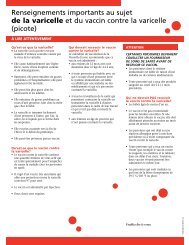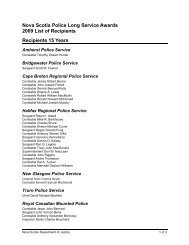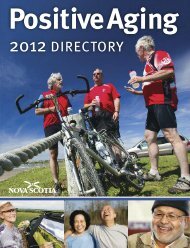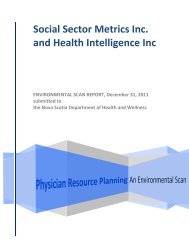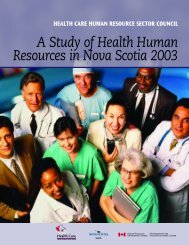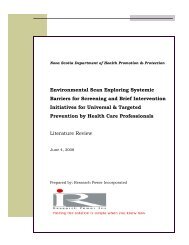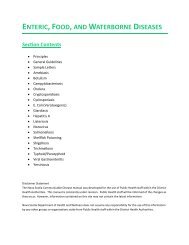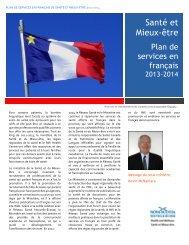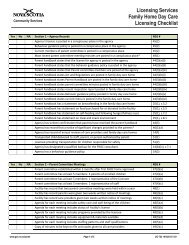Internal Communications—It's Not Rocket Science - Government of ...
Internal Communications—It's Not Rocket Science - Government of ...
Internal Communications—It's Not Rocket Science - Government of ...
Create successful ePaper yourself
Turn your PDF publications into a flip-book with our unique Google optimized e-Paper software.
A MANAGER’S GUIDE TO COMMUNICATING WITH EMPLOYEES
© Crown copyright, Province <strong>of</strong> Nova Scotia, 2010ISBN: 0-88871-981-7This publication was prepared by theCommunications Planning Section <strong>of</strong>Communications Nova Scotia.An electronic copy <strong>of</strong> this guide and more informationon <strong>Internal</strong> Communications are available atwww.gov.ns.ca/cmns/rocketscienceWritten by Kevin Finch, Chris Hansenand Rick AlexanderDesign and illustration by Shelley Vienot Spencerfor Communications Nova Scotia
C O N T E N T SPage 1:Communication MattersPage 2:<strong>Internal</strong> Communications:Policy StatementPage 9:<strong>Internal</strong> Communications:Quick GuidePage 19:<strong>Internal</strong> Communications:The DetailsPage 55:Appendix IEffective MeetingsPage 57:Appendix IIOh, One More Thing:Plain Language
Communication matters.In fact, communicating with employees is one <strong>of</strong>the most important things you do as a leader.I N T R O D U C T I O NScads <strong>of</strong> research shows that people derive greatersatisfaction from their jobs and perform to a higherstandard when they are engaged in their workplace.Effective communications is an essential feature <strong>of</strong>engagement.Communicate effectively and you’ll have a morefully engaged and more productive workforce.(Then you’ll be promoted to deputy minister.)“The art <strong>of</strong> communication is thelanguage <strong>of</strong> leadership.”— James C. HumesThis guide provides very practical suggestions tohelp you decide how best to communicate with staffin different situations. Keep it handy. Feel free todiscuss these approaches with your nearestcommunications director or advisor.And remember, while the stakes are high, the hurdleisn’t.You can learn to communicate effectively with yourstaff. It takes some planning. It takes practice andcommitment. It’s a skill you can continue to hone.<strong>Internal</strong> communications is critically important,but it isn’t rocket science.A M A N A G E R ’ S G U I D E T O C O M M U N I C A T I N G W I T H E M P L O Y E E S 1
C O M M U N I C AT I O N S F O R T H E21 ST CENTURYI N T E R N A L C O M M U N I C AT I O N S P O L I C Y S TAT E M E N TRecognizing that its employees are its most valuable resource and are entitled toquality internal communications, it is the policy <strong>of</strong> the <strong>Government</strong> <strong>of</strong> Nova Scotia tokeep government employees informed and up-to-date about government initiatives,departmental plans and progress, human resource developments, and overallgovernment progress through a comprehensive internal communications process.S TAT E M E N T O F P R I N C I P L EPreambleAny organization’s greatest resource is its people. The <strong>Government</strong> <strong>of</strong> Nova Scotiais no exception. The some 10,000 people who make up the government’s workforceare responsible for turning decisions made in the Cabinet room and on the floor<strong>of</strong> the Legislature into something real, something tangible for the people <strong>of</strong> thisprovince. Our government workforce makes it possible for Nova Scotians to enjoypaved roads, good health care, public education, clean air, criminal justice and amyriad <strong>of</strong> other essentials.It is in the interest <strong>of</strong> all Nova Scotians that provincial government employees arecommitted, productive and conscientious. For employees to actually be committed,productive and conscientious, they must feel valued. A combination <strong>of</strong> factors contributeto the employee’s sense <strong>of</strong> value, and one <strong>of</strong> these – effective communication –is absolutely essential.2I N T E R N A L C O M M U N I C A T I O N S : I T ’ S N O T R O C K E T S C I E N C E !
From a communications perspective, employees feel appreciated and valued when• they are the first to hear important news• they are regularly consulted• they are listened to• their suggestions are acted upon.Principles <strong>of</strong> effective internal communications• <strong>Internal</strong> communications is essential to the government’s overall effectiveness.• <strong>Internal</strong> communications is a responsibility <strong>of</strong> a department’s management; notits communications section. Communications can, however, provide managerswith guidance and coaching.• <strong>Internal</strong> communications is meant to help inform decision making and influenceemployee behaviour in ways that benefit government, the public, and employeesthemselves.• <strong>Internal</strong> communications consists <strong>of</strong> accurate, consistent, and timely information.• <strong>Internal</strong> communications is always two-way communications. Employeefeedback helps managers decide if the communication has been received andunderstood. As well, employees have important operational information thatcan help to make the government more successful in achieving its goals.• <strong>Internal</strong> communications never stops. It is a continuous interactive process.A M A N A G E R ’ S G U I D E T O C O M M U N I C A T I N G W I T H E M P L O Y E E S3
Why Communicate?“When in doubt,tell people too much.”— Robert Waterman Jr., co-author <strong>of</strong>In Search <strong>of</strong> ExcellenceEffective managers and supervisors already know afew things about communicating with employees.Communication helps to build relationships, promotesmutual understanding, and enables employees tocontribute to organizational success. Moreover, it’s askill that can be learned – but it takes practice.Effective managers and supervisors also know thatcommunicating with employees is not solely theresponsibility <strong>of</strong> the organization’s pr<strong>of</strong>essionalcommunicators, any more than managing their <strong>of</strong>fice’sbudget is the sole responsibility <strong>of</strong> the organization’sfinance pr<strong>of</strong>essionals. The communications folks canhelp and can provide advice, but the “heavy lifting”remains the manager’s responsibility.T H E R O L E O F T H E M A N A G E RA N D S U P E R V I S O RStudies have long shown that employees prefer toreceive information from their supervisors. Theylike to get the “big picture” information from theorganization’s leaders, but they want to hear theimpact on their workgroup directly from the peopleto whom they report.For many types <strong>of</strong> information, employees also preferto receive news face to face. This allows for interactionand a chance to close the communication loop: thesupervisor “sends out” the message, the staff receiveit, and their reaction or response shows if theyunderstand and accept the information.4I N T E R N A L C O M M U N I C A T I O N S : I T ’ S N O T R O C K E T S C I E N C E !
C O M M U N I C AT I O N T H AT W O R K SAfter studying 10 international companies andconducting an exhaustive literature review,Deloitte & Touche identified four communicationrelatedfactors that help organizations achievetheir goals.“All your people must learn beforeyou can reach for the stars.”— Capt. James Tiberius Kirk1 Clarity <strong>of</strong> purposeSuccessful organizations and initiatives focus on afew key messages. Leaders in successful organizationsare consistent in their messages and ensure thateveryone involved understands the goals and howto achieve them.2 Effective communication methodsThe level <strong>of</strong> trust and openness in various keyactivities is also critical for success. Employees atall levels can ask for information and receivehonest, useful answers.3 Effective sharing <strong>of</strong> informationInformation sharing is effective when systems andnetworks enable managers and employees to havethe right information at the right time to do theirjobs, to share opinions and discuss ideas, and tocirculate best practices and learn from each other.4 Walking the talkLeaders must also be good communicators themselves,so they can convey their ideas convincingly.Their behaviour must be consistent with what theyare saying, both formally and informally.A M A N A G E R ’ S G U I D E T O C O M M U N I C A T I N G W I T H E M P L O Y E E S 5
“The single biggest problem incommunication is the illusion thatit has taken place.”— George Bernard ShawResearch by international consulting firm WatsonWyatt identified key communication differencesbetween high-performance and other organizations• High-performing organizations focus on communicatingwith and educating their employees.Communications programs in high-performingorganizations place a greater emphasis on helpingemployees understand their business, its valuesand culture, its progress toward goals, and howemployees can improve performance.• High-performing organizations do a better job <strong>of</strong>explaining change. Fifty per cent <strong>of</strong> the respondentsin high-performing organizations were satisfiedor very satisfied with how effectively theirdownwards communications programs explainedand promoted major changes in the organization,compared to 39 per cent <strong>of</strong> respondents fromall other organizations.• High-performing organizations provide channelsfor upward communication and listen to whatemployees say. More respondents from highperformingorganizations than from all othersrated their upward communication channels aseffective and reported that employee input wasused in decision making.Communication between you and your staff can playan integral role in the success <strong>of</strong> your organization.Invest some time in improving communications andreap the benefits. Your organization’s communicationsstaff can help you if you need further informationon developing and implementing an employeecommunications program.6I N T E R N A L C O M M U N I C A T I O N S : I T ’ S N O T R O C K E T S C I E N C E !
How . . . and When?The challenge for managers and supervisors is t<strong>of</strong>ind the time and the most effective methods forcommunicating information in a timely and openway to their staff. When faced with a specific messageto convey, managers must decide which internalcommunications tool(s) will be most effective.First, consider the following:“You can have brilliant ideas, butif you can’t get them across, yourideas won’t get you anywhere.”— Lee Iacocca• The nature <strong>of</strong> the messageHow important is it? How complex is it? Whatimpact will this information have on operations?What impact will this information have onemployees? Will it have any impact on employees’families? When will these impacts be felt?Generally, the more complex or the more importantthe message, the more likely that face-to-face communicationis warranted. This should almost alwaysbe supplemented by a printed or electronic versionfor clarity and consistency <strong>of</strong> message. E-mail orvoice broadcast can be used as a reminder or update.• The messengerWho is the most appropriate source <strong>of</strong> this information:the employee’s supervisor, manager, director,executive director, deputy minister, or minister?Employees generally prefer to hear from theirdirect supervisor, but “big picture” news may bemore appropriate coming from senior managementor the minister.• The timing <strong>of</strong> the messageWhen should the message be delivered? Thecardinal rule on timing is that employees shouldalways know about something that affects thembefore anybody else knows. Employees feel morevalued if they become aware <strong>of</strong> informationbefore it is public knowledge.A M A N A G E R ’ S G U I D E T O C O M M U N I C A T I N G W I T H E M P L O Y E E S 7
“The basic building block <strong>of</strong> goodcommunication is the feeling thatevery human being is unique and<strong>of</strong> value.”— UnknownThe following pages contain a Communications Toolkitto help you assess your communications needs andfind the right way to communicate with your staff.The Quick Guide is an overview in table form <strong>of</strong> thecommunications tools available, with a brief description<strong>of</strong> why each tool should be used and when andhow <strong>of</strong>ten to use it. This is followed by more detaileddescriptions <strong>of</strong> each method, including the pros andcons <strong>of</strong> using it and technical considerations.8 I N T E R N A L C O M M U N I C A T I O N S : I T ’ S N O T R O C K E T S C I E N C E !
<strong>Internal</strong> Communications Quick Guide“How can I best communicate with employees?”F O R M A L FA C E - T O - FA C EDescription Why? When or How Often?All-Staff “Big Picture” Meetings(Page 19)To help employees understand theirdepartment’s goals and how their workfits into the big picture.• On an annual basis to communicatebusiness plan information• To communicate information withdepartment-wide implications suchas a reorganization, auditor’s statement,or accountability reportDepartment-wide meetingIn larger departments, it may be moreappropriate to break this down intoregional meetings (Page 22)For regular and routine communications;may be necessary to convey an unexpectedbut important message that has abroad impact.• On an annual basis for routinecommunications• On an as-needed basis for importantsudden and/or far-reaching newsWorkgroup or staff meeting(Page 24)For information sharing, updating,assigning tasks.• Weekly or bi-weeklyQ U I C K G U I D E
<strong>Internal</strong> Communications Quick GuideF O R M A L FA C E - T O - FA C EDescription Why? When or How Often?Small-group cross-divisional meeting(Page 25)As a vehicle for informal chat.Participants share information abouttheir various areas and get to know colleaguesin other parts <strong>of</strong> the department.The deputy or director gains insights,listens to concerns, and is able to answerany questions that arise.• On a regular basis. Monthly orbi-monthly• Particularly good to gauge reactionto new programs or initiativesManagement forum(Page 27)Half- or full-day gatherings <strong>of</strong> allmanagers in the department or agencyto discuss management issues.It provides the opportunity to refocusas a management team on departmentalgoals and strategies.• Once or twice yearly; perhaps as muchas quarterly in bigger departmentsSenior management meeting chaired bythe deputy or agency headFor information sharing and decisionmaking.• Weekly or bi-weekly
<strong>Internal</strong> Communications Quick GuideI N F O R M A L FA C E - T O - FA C EDescription Why? When or How Often?Director/manager walkabout(Page 29)To stay in touch with front-lineemployees and front-line operations.• On a regular basis. Every few weeksor even more frequently as neededDeputy walkabout(Page 29)To stay in touch with employees andon top <strong>of</strong> operations in all sectionsand divisions.• Depending on the size <strong>of</strong> thedepartment it may be monthly oras infrequently as quarterlyMinister walkabout(Page 29)To stay in touch with the people whobring minister’s decisions to fruition.• Once or twice a yearTechnology is making us more efficient than ever at sharinginformation, yet over-reliance on technology can actually result inlower quality communications.Communication is about relationships as well as information.And sometimes, an e-mail isn't enough.
<strong>Internal</strong> Communications Quick GuideV O I C EDescription Why? When or How Often?Telephone: call inThe employee calls in (Page 31)For employees to have easy access tovital information from any location.• To update employees on labourdisruptions; workplace closures (storms,hazards, etc.); project roll-outs; etc.Telephone: call out(Page 32)For employees to be alerted to departmentnews. A primary method forroutine messages, updates; a secondarymethod as a follow-up or reinforcement<strong>of</strong> an important message deliveredearlier face to face.• To update employees on labourdisruptions; workplace closures(storms, hazards, etc.); projectroll-outs; etc.PA P E R A N D D I S P L AYDescription Why? When or How Often?Mission statement display(Page 33)To serve as a reminder <strong>of</strong> the department’sraison d’être and to provide focus. Thedepartmental mission statement should beprominently and conspicuously displayed.• Should be a permanent fixture incommon areas across the department
<strong>Internal</strong> Communications Quick GuidePA P E R A N D D I S P L AYDescription Why? When or How Often?Vision and values statement display(Page 33)To remind employees where the governmentand their own department isheaded and by what values this will beaccomplished. The departmental visionand values should be prominently andconspicuously displayed.• Should be a permanent fixture incommon areas across the departmentHandwritten or typed letter or note To convey a personal message <strong>of</strong>appreciation to an individual employeeor to a workgroup. This should be keyto any employee recognition program.• When the situation warrants – andthe situation is <strong>of</strong>ten warrantedNewsletter(Page 35)As a team builder and morale booster thanas a news source. Pr<strong>of</strong>iling employees and<strong>of</strong>fices or sections and including featureson initiatives in all areas <strong>of</strong> the department<strong>of</strong> agency helps build team spirit and providesinformal recognition. Paper as amedium allows the employee to take ithome more easily to share with the family.• Depending on the size <strong>of</strong> thedepartment, could be weekly,monthly, bi-monthly, or quarterly
<strong>Internal</strong> Communications Quick GuidePA P E R A N D D I S P L AYDescription Why? When or How Often?Bulletin board(Page 38)Primarily, as a source for routine newsand upcoming events and a secondarysource for more important informationinitially conveyed face to face or by othermeans. Lunchrooms, water coolers, andelevator lobbies are ideal locations forbulletin boards.• Should be used on an ongoing basisSuggestion box(Page 39)To allow employees to make suggestionsfor operational improvement; to giveemployees a voice in deciding how tomake things work better.• Should be used on an ongoing basisWe're all bombarded with a blizzard <strong>of</strong> data during a typical day at the<strong>of</strong>fice. Key information needs to be repeated to make sure it gets through.If it's important, say it more than once.
<strong>Internal</strong> Communications Quick GuideE L E C T R O N I CDescription Why? When or How Often?E-mail(Page 40)Primarily to convey routine messages,updates. It can also be used as a secondarymethod for follow-up or reinforcement <strong>of</strong>an important message delivered earlierface to face. Users should take care not toabuse or overuse e-mail, and avoid usingit for sensitive or complex matters. Whenin doubt, pick up the phone or go visit.• Whenever neededIntranet(Page 42)To provide information that is routine oroperationally important. This is essentially,a private Internet. The tools used to createand to view content are the same; anytype <strong>of</strong> material that can reside on theInternet can live on an intranet. Themain difference is that the intranet canbe accessed only from a computer thatis behind the corporate firewall, meaningthat people outside <strong>of</strong> government do nothave access to the material.• Should become a routineinformation resource for employees
<strong>Internal</strong> Communications Quick GuideE L E C T R O N I CDescription Why? When or How Often?Online video(Page 44)For an important message that hasdepartment-wide or government-widesignificance. This is an embellishmenton e-mail. The audience is eitherdirected to a website where they watcha video message from the minister,deputy, etc., or the file is attached to ane-mail. The former approach is preferredbecause it puts less strain on thegovernment computer network.• Only for extremely importantannouncementsNews bulletin(Page 46)To ensure that employees learn departmentalor government news before theyhear it through the media. This can bedone through e-mail or bulletin boards.• Just before or simultaneous toissuing a news releasePodcast(Page 48)To convey a direct, personal messagefrom an interesting personality; themessage doesn’t get filtered• When there is something interestingto say or on a regular schedule like aradio program
<strong>Internal</strong> Communications Quick GuideE L E C T R O N I CDescription Why? When or How Often?Blog(Page 50)To keep teams or clients informed, tocreate a culture <strong>of</strong> information sharing,to facilitate two-way communication.• Must be kept current• Twice a week if not dailyWiki(Page 52 )To produce a collaborative product:everyone has input, so everyoneshould be able to agree on a finishedproduct.• Whenever many people have inputon content• Whenever consensus is important,for example on internal policyIf it’s really important, say it more than once.
There are many ways to communicate with your staff.One approach, or set <strong>of</strong> approaches, will be more suitable in some workgroups, or somesituations than others. But there is no substitute for a personal, face to face exchange.No matter what else you do, you should hold regular meetings with your workgroup.I N T E R N A L C O M M U N I C A T I O N S : I T ’ S N O T R O C K E T S C I E N C E !
<strong>Internal</strong> Communications:The DetailsF O R M A L FA C E - T O - FA C EAll-Staff “Big Picture” MeetingsIt is crucial that staff members understand the overall goals <strong>of</strong> government, theirdepartment’s goals, and how their work fits into that big picture. In a 2004 governmentwideemployee survey, one in three staff members said they didn’t know how theirwork contributed to the department’s overall purpose and priorities. Half said theyhad not received communications about their department’s business plan in thepast 12 months.Good For• all departments and agenciesPros• It shows staff how they and their department/agency help the governmentto meet its priorities and commitments.• It helps to break down silos.• Staff feel part <strong>of</strong> the solution.• Staff are better able to explain government’s actions in un<strong>of</strong>ficial, social settings.T H E D E TA I L SCons• It takes time and commitment from management.• Buy-in can be affected if staff disagree with government’s priorities andcommitments (minimal, but a factor).A M A N A G E R ’ S G U I D E T O C O M M U N I C A T I N G W I T H E M P L O Y E E S19
All-Staff “Big Picture” MeetingsDetailsPlease note: For brevity, this section talks about communicating with staff about thebusiness plan. The steps outlined below could equally apply to an accountability report,an auditor’s statement, or any other major document or initiative that would havedepartment/agency-wide implications.A department or agency’s business plan should be developed with input from staff.Once it’s complete, you can then figure out how you will share it with all employees.Steps to communicate business plan information will vary from department todepartment, depending on the number <strong>of</strong> staff involved, when and where they work,etc. However, the following approach should work in most situations.It consists <strong>of</strong> four steps:• broadcast message to staff• department/agency-wide or regional meeting (optional)• managers’ meeting• small-group meetingsBroadcast message to staffTo start, all staff should receive an e-mail from the deputy minister on the morning<strong>of</strong> the day that plans are made public. The message should include a link to theonline version <strong>of</strong> the business plan or an electronic copy <strong>of</strong> the plan. Print copiesshould be available for staff members who do not have access to a computer. Themessage should also state that senior managers will meet with staff to explain theplan and answer questions in the near future.Department/agency-wide or regional meetings (optional)Department-wide meetings are described below. This step is optional becausesmall-group meetings will probably best serve the needs <strong>of</strong> management and staff.Managers’ meetingManagers should meet with their deputy and business planning committee toprepare for meetings with staff. Communications will prepare talking points forthe deputy and planning team and use the feedback from this meeting to fine-tunetalking points and support materials that will be made available during the meetingswith staff.20I N T E R N A L C O M M U N I C A T I O N S : I T ’ S N O T R O C K E T S C I E N C E !
Small-group meetingsWithin two to three calendar days <strong>of</strong> the business plan’s release, senior managersshould meet with staff on an <strong>of</strong>fice-by-<strong>of</strong>fice (for field <strong>of</strong>fices) or divisional/branchbasis (for larger <strong>of</strong>fices) to provide more detail and to answer questions as a follow-upto the deputy’s earlier e-mail message to all staff. (This is also an opportunity tohave a walkabout; see that toolkit topic for more details.)Communications will provide talking points for the managers. Employees’ questionsthat cannot be answered at the meeting should be addressed through e-mail, anintranet site, or in future meetings – but they must be addressed.The meeting should be led by the senior manager for the group (regional manager,executive director, assistant deputy minister, etc.) and should include the group’srepresentative in the planning process (if it is not the senior manager). During themeetings, managers will explain the rationale for the plan and how the unit fitsinto the plan, explore priorities that pertain directly to the unit, and answer questions.Next StepsBusiness plans are published at budget time (March/April); plan the meetings asthe business plan is being finalized. (Accountability reports are usually released inDecember; plan meetings for early January.)Management and staff should meet at least on a quarterly basis to stay abreast <strong>of</strong>progress being made on the business plan. Preparing for these sessions will also helpmanagement to prepare progress reports to submit to the central agencies. On anongoing basis, new projects and assignments need to be tied to achieving thedepartmental/agency business plan and to the government business plan.A M A N A G E R ’ S G U I D E T O C O M M U N I C A T I N G W I T H E M P L O Y E E S21
Department-Wide MeetingThis is a short meeting (30–60 minutes), hosted by senior management, that isintended to provide high-level information about a significant event or aboutbig-picture progress.Good For• major events that have department-wide results (business plan or annualbudget, restructuring, etc); could also be division-wide, region-wide, etc.,as the situation warrantsPros• The audience hears the same message at the same times.• It puts senior management in front <strong>of</strong> staff.• Information can be delivered personally, to a large audience, in a relatively short time.• Staff have an opportunity to ask questions and receive answers.• Senior management have an opportunityt to update staff on organization-wideissues and reinforce links between their efforts and government goals.Cons• There is an impact on service delivery while staff attend the meeting: fewerstaff at work, longer waits for clients.• Large groups can intimidate some people, preventing them from asking questions.• Some people like to grandstand.• It can be expensive: renting a hall/theatre, travel and accommodation, etc.DetailsStaff <strong>of</strong>ten want to receive information from the people they perceive are drivingsignificant events or changes in an organization. This is usually the deputy ministeror executive director(s) and sometimes the minister.Department-wide meetings are usually scheduled to announce or communicatea significant event, such as a fiscal year review, business plan, or governmentrestructuring. The information shared is usually “big picture.” Sometimes thedetails surrounding the event are still unclear.22 I N T E R N A L C O M M U N I C A T I O N S : I T ’ S N O T R O C K E T S C I E N C E !
It can be tempting to wait until more information is available before communicating,but staff may perceive this as avoiding the issue or a lack <strong>of</strong> respect or concern forstaff. Often, staff want to hear their department’s leader acknowledge their informationneeds and concerns and to get assurances that they will receive more information ata later date. Sometimes they need to vent frustration, although they are expected tobe civil and pr<strong>of</strong>essional towards management and other members <strong>of</strong> the audience.Staff come to a central location, usually away from the workplace, for a presentation.The information shared should address issues that will affect the audience directly.Often, there is a question and answer session. Q&A sessions are usually lessconfrontational when the information is not controversial (the introduction <strong>of</strong>a business plan as opposed to job losses). Light refreshments can be available;the meetings usually run 30–90 minutes.Meetings should take place during the audience’s normal working hours becausestaff have other after-work commitments. In larger departments, or where clientservice needs warrant, meetings can take place on a regional or organizationallevel (e.g., all staff from the southern region or all department staff from highwaymaintenance). When these smaller meetings are held, it is best when they are heldwithin a short time span (on the same morning/afternoon or at least on the sameday). Otherwise, the rumour mill ramps up, e-mails are exchanged, phone callsare made, and management loses the communication lead.Handouts or information kits should be distributed or posted on an intranet sothat staff can later review the information they receive at their own pace. This alsoincreases the accuracy <strong>of</strong> “pass-along” information to those staff who may not havebeen present. Handouts should be distributed after the meeting; otherwise, the audienceis more focused on reading the handout than on listening to the presentation.Consider staff with special needs. Does anyone need an American Sign Languageinterpreter? Are venues accessible for people with mobility challenges?Next StepsFollow-up department-wide meetings may occur, but it is preferable that managersand supervisors deliver additional information when it becomes available. Thisreinforces middle management’s role in the organization as a two-way conduit <strong>of</strong>information between senior management and staff. Talking points or presentationsshould be provided so staff receive consistent information.A M A N A G E R ’ S G U I D E T O C O M M U N I C A T I N G W I T H E M P L O Y E E S23
Workgroup or Staff MeetingStaff meet regularly to discuss internal and external operational issues facing theunit or section.Good For• small- to medium-size groups: a branch at head <strong>of</strong>fice, a team, or all staff at a field <strong>of</strong>fice• committees (occupational health and safety, etc.)Pros• Management and staff stay abreast <strong>of</strong> existing and pending issues.• Management and staff stay abreast <strong>of</strong> progress made on corporate initiatives.• Decisions and directions are communicated.• It allows for exchange <strong>of</strong> perspectives and knowledge.• It provides opportunity to ask questions and clarify understanding.Cons• In small locations, there could be client service implications.DetailsStaff meet to discuss the issues <strong>of</strong> the day, department news. Managers share informationthey have received from senior management about major government and departmentalinitiatives. Operational decisions can be made, and tasks may be assigned.Frequency is variable and should be set by the workgroup. In very fluid situations,daily meetings lasting 5–10 minutes may do the trick. In other situations, theteam may need only to get together on a weekly or biweekly basis.The traditional agenda would have the team leader speak first to share informationwith staff. Then, a roundtable gives staff a chance to speak to tasks they are workingon, pending issues they see on the horizon, etc. Colleagues take their cues and adjusttheir workload accordingly. For example, a policy analyst might note that a discussionpaper will be in approvals this week and is expected to be distributed in two weeks’time. Support staff would then agree to arrange to print the discussion paper andmailing labels, order envelopes, etc. At the next meeting, the support staff mightpoint out that all is ready for distributing the discussion paper, etc.The benefit <strong>of</strong> this tool is that it reinforces the sense <strong>of</strong> team; it keeps peopleinformed about issues and project management; it opens the door for other levels<strong>of</strong> communication. Management and staff are all in the loop on issues and projects,and their information came directly from the source.24I N T E R N A L C O M M U N I C A T I O N S : I T ’ S N O T R O C K E T S C I E N C E !
Small-Group Cross-Divisional MeetingA program designed to exchange information both vertically and horizontallyacross the department and delivered in a format that strengthens team spirit andfosters morale.Good For• all departmentsPros• There is a common format: e.g., breakfast with the deputy/executive director.• The program builds visibility <strong>of</strong> senior management; attendees meet with seniormanagement and put names to the faces• It can build understanding <strong>of</strong> why some decisions are made: attendees see theirpersonal role and their unit’s role, in the big picture;• It builds understanding that senior management is aware <strong>of</strong> issues facing staff.• Attendees become acquainted with others in the department and hear theviewpoints <strong>of</strong> colleagues in other sections.• Attendees express their views and alert senior management to issues.• The program builds team spirit and fosters morale.Cons• Some say that these sessions weaken middle management, that staff go aroundtheir managers to the top. Others counter that staff do not go around middlemanagers who address – or at least acknowledge – issues raised by staff.• Senior management gets involved in operational minutiae, things that middlemanagement is paid to deal with.A M A N A G E R ’ S G U I D E T O C O M M U N I C A T I N G W I T H E M P L O Y E E S 25
DetailsThis tool has been used in a number <strong>of</strong> organizations, in both the public and privatesectors, with good results.A common scenario is breakfast or lunch with the deputy. It would also work withan ADM or an executive director, someone whom staff do not normally accessinformally on a regular basis. The refreshments are light, so the dialogue remainsthe focus, not the meal. (Consideration must be given to dietary, religious, andcultural factors when choosing dates and menus.)The meeting is informal; attendees are encouraged to share their views, to raiseissues, etc. A typical session would last 45 minutes to an hour and occur on a regularbasis (weekly, monthly, quarterly).The leader has a dual role, as host and as facilitator. They can’t just walk into theroom, sit down, and expect conversation to flow. They need to ask open-endedquestions, which are difficult to answer with a simple yes or no, and try to drawout attendees who are not forthcoming with their thoughts. If your executive feelsawkward hosting these sessions, add a staffer who can moderate.The number <strong>of</strong> attendees should be kept small (6–12), so no one feels intimidated.The one steadfast rule is that a no one attends the same session as someone whoreports directly to them, again to reduce the intimidation factor. Still, some peoplemay not speak their mind because they suspect their views will could get back totheir supervisor/manager and be held against them.Most <strong>of</strong>ten, attendees are randomly selected from across the organization; there isno set topic. Sometimes, there is a common tie between the attendees that forms a“theme” for the meeting. For example, the executive may want grassroots feedbackas to how a recent reorganization is affecting operations and client satisfaction.If the organization is going through change, it is important to approximate wherethe organization and the attendees are on the change cycle (denial, resistance,negotiation, acceptance).26 I N T E R N A L C O M M U N I C A T I O N S : I T ’ S N O T R O C K E T S C I E N C E !
Management meetings may be timed to coincide with the start <strong>of</strong> the businessplanning cycle or a significant event, such as a government restructuring.Compared to shorter department-wide meetings, management meetings <strong>of</strong>tenexplore the most up-to-date information to develop action plans and how thisinformation will be shared with staff.Handouts or information kits may be appropriate, because the meetings can be longand can cover a lot <strong>of</strong> topics. Managers might duplicate the handouts and sharethem with staff or use the information in them to deliver consistent messages tostaff about issues and events. Staff do communicate between <strong>of</strong>fices, so consistentmessaging is critical.As with department-wide meetings, appropriate accommodation must beconsidered for managers with special needs.Next StepsThe deputy minister or agency head should follow up with managers to ensurethat the meeting met both their needs and those <strong>of</strong> the organization.28 I N T E R N A L C O M M U N I C A T I O N S : I T ’ S N O T R O C K E T S C I E N C E !
I N F O R M A L FA C E - T O - FA C EWalkaboutsAs the name implies, leaders tour a facility or work site to gain first-hand experiencein the operation <strong>of</strong> their organization. Staff can “strut their stuff” and share ideasand concerns with leaders in less formal situationsGood For• all departmentsPros• A walkabout acquaints the new executive with their department and introducesthem to their staff.• It allows executives to demonstrate understanding <strong>of</strong> the work and pressuresfacing staff.• It is informal, inexpensive and involves only a short time commitment.• It keeps executives in touch with front-line staff.• It can be spontaneous and unscheduled.• When a minister or executive is travelling, a walkabout can be added to their agenda.Cons• Some dispute the value <strong>of</strong> walkabouts, saying that they do not always accuratelyrepresent the work environment. Too much “tidying up” can be done if thewalkabout is scheduled.DetailsFormal walkabouts occur most frequently after a new minister or deputy ministerhas been appointed and are scheduled over the initial three or four months intheir new responsibility. Walkabouts are less common with a new executivedirector who is more likely to meet with operational staff during the course <strong>of</strong> theday. Ministers and deputies walkabout more frequently in Halifax than in the regions,because that’s where their <strong>of</strong>fices are located. However, it is important to get theminister and deputy outside <strong>of</strong> metro, because operations and clients may bevery different than they are in metro. Directors and managers should makeevery effort to be in the workplace with staff.A M A N A G E R ’ S G U I D E T O C O M M U N I C A T I N G W I T H E M P L O Y E E S29
Walkabouts are not exclusive to ministers and deputies. It is important thatexecutive directors and managers keep in touch with front-line operations, andbrief, unscheduled walkabouts are a good way to do that. The manager is givenan opportunity to see what is happening first-hand, and employees are given anopportunity to explain their jobs, to pass along, information or concerns, andto ask questions. These walkabouts should occur every few weeks.Scheduled, more formal, walkabouts are brief; the executive is given a 15- to 30-minutetour <strong>of</strong> the <strong>of</strong>fice or facility. Depending on the circumstances, they may meetclients. Some walkabouts are more inclusive. In addition to the tour, the executivemay meet with management, with staff, or with stakeholders from the area.30I N T E R N A L C O M M U N I C A T I O N S : I T ’ S N O T R O C K E T S C I E N C E !
PA P E R A N D D I S P L AYVision, Values, and Mission StatementsVision and values statements define how an organization sees itself or wantsothers to see it.A mission statement explains why the organization exists or what it does.Good For• any department or organizationPros• They build cohesive direction within an organization.• They crystallize the purpose, direction, and values <strong>of</strong> an organizationCons• They can be meaningless if not reflected in the leaders <strong>of</strong> the organization.• Developing a vision, a values statement, and a mission statement can becomea complicated process.Details• An effective mission statement is best developed with input by all the members<strong>of</strong> an organization.• Keep them short but comprehensive enough to be <strong>of</strong> value.• Avoid saying how great you are: what great quality and what great serviceyou provide.• Examine other organizations’ statements, but make certain your statement isyours and not that <strong>of</strong> some other organization.• Make sure that the majority <strong>of</strong> the organization truly believes in its vision, values,and mission statements.• The organization should communicate its mission, vision, and values statementsto all employees through media such as newsletters, bulletin boards, intranet, etc.• Pr<strong>of</strong>essionally printed and framed copies can be displayed, so staff andmanagement are constantly reminded <strong>of</strong> the organization’s vision, values, andmission. These can be placed in staff rooms, boardrooms, main entrances, etc.A M A N A G E R ’ S G U I D E T O C O M M U N I C A T I N G W I T H E M P L O Y E E S33
Elements <strong>of</strong> a Mission Statement• The Purpose Element clearly states what your organization seeks to accomplish:Why does your organization exist? What is the ultimate result <strong>of</strong> your work?• The Business Element outlines the “business(es)” (i.e., activities or programs)your organization chooses in order to pursue its purpose. Specifically, youmust answer, “What activity are we going to do to accomplish our purpose?”• The Values Element lists beliefs that your organization’s members hold in commonand endeavour to put into practice. The values guide your organization’s membersin performing their work. Specifically, you should ask, “What are the basicbeliefs that we share as an organization?”The public service values for the government <strong>of</strong> Nova Scotia are:• respect• integrity• diversity• accountability• the public goodDepartments may want to add others that focus specifically on the mission andgoals <strong>of</strong> the department.34I N T E R N A L C O M M U N I C A T I O N S : I T ’ S N O T R O C K E T S C I E N C E !
NewsletterA regular department- or organization-wide publication, to which employeesare encouraged to actively contribute, that can be used to provide generalinformation to all employees.Good For• any departmentPros• A consistent message reaches all employees, regardless <strong>of</strong> classificationor location.• Employees can contribute.• Employees can learn about other units in the department.• Employees can see their role, or their unit’s role, in the big picture.• Employees can learn about each other, pr<strong>of</strong>essionally and personally.• A newsletter can be a recognition/incentive tool.• It can be a team-building tool for the people involved in putting it together.• There is no technology demand for the audience; a newsletter can beconsumed at the reader’s convenience and stored for future reference.Cons• Production requirements make this a time-consuming option.• Employee buy-in and participation may be slow to develop (or mightnever develop).• It can be time consuming for the editor; other work responsibilities mustbe taken into account.A M A N A G E R ’ S G U I D E T O C O M M U N I C A T I N G W I T H E M P L O Y E E S35
DetailsIn basic terms, this tool resembles an employee newspaper or magazine. It can beproduced in a variety <strong>of</strong> formats, in colour or black and white, and the frequencycan vary. Traditionally, these are monthly or quarterly publications.The publication can be simple or complicated, considering the audience and thecontent; both have their pros and cons. For example, a manager may want to publisha simple newsletter to minimize cost and staff time; staff may interpret this asmeaning that they are insignificant. On the other hand, a glossy colour publicationmay be resented by staff, who say that the money would be better spent on training,program support, etc. The needs and desires <strong>of</strong> the audience must be gaugedbefore committing to a format.Content is usually feature-oriented, people-focused, and light. It can be used toreinforce or expand on other communication tools (e-mail, bulletin, etc.).Content options include, but are not limited to, the following:• human interest stories, involving employees: e.g., hobbies, vacations, pets• pr<strong>of</strong>iles <strong>of</strong> workgroups or individual employees• new/departing staff, promotions, transfers• employee recognition: e.g., long service awards, training, graduation• general announcements• new policies or procedures• departmental accomplishments: e.g., the response by TPW’s snowplow operatorsduring a blizzard• corporate sports and social events• promotion for United Way or other charitable projects• health and wellness information• marriage, birth, and death announcementsNewsletters can be perpetually ongoing, or they can be tied to a significant eventsuch as a reorganization or special project.36I N T E R N A L C O M M U N I C A T I O N S : I T ’ S N O T R O C K E T S C I E N C E !
Content must always reflect public service goals <strong>of</strong> tolerance and inclusivityand remain apolitical. Never assume that a newsletter is an “internal” document.Material that is confidential or potentially embarrassing to the department, itsstaff, or its clients will likely find its way outside.Photographs and illustrations are powerful communication tools and should beincluded in a newsletter whenever feasible. They do not need to be pr<strong>of</strong>essionalcaliber, but they do need to be “readable.”Newsletters are traditionally printed and distributed; in many cases, electronic copiesin pdf format are archived on an intranet. It is less costly to print and distribute anewsletter than to e-mail it to staff and expect them to print it. Electronic distributionis even less effective when staff have limited access to technology. It is preferable todeliver a copy directly to each employee; but delivering sufficient copies to centralsites (one per floor, one per field <strong>of</strong>fice, etc.) is also acceptable.Resource IssuesTechnologyAs mentioned earlier, newsletters can come in a number <strong>of</strong> formats and levels <strong>of</strong>sophistication. At the low end, a simple newsletter can be developed using a wordprocessing program. At the high end, bells and whistles such as colour, illustration,page size, etc., may call for a design pr<strong>of</strong>essional. Even a low-end newsletter requiresskills over and above day-to-day word processing, so training will be a factor.Additional techniques and technology such as scanning, digital cameras, duplexprinting, tabloid printing, etc., must also be taken into account.StaffingMany newsletters are produced by communications staff in a department or agency,but this is not mandatory. In some cases, communications may act solely as an editoror advisor to a publication. By all means, keep communications and senior managementin the loop about content and issues facing the newsletter. In most cases, anewsletter committee is a good option. A committee ensures regional and divisionalrepresentation in the publication and serves to share the production workload.Next StepsRegardless <strong>of</strong> the style, format, and frequency <strong>of</strong> the newsletter, it should be evaluatedon a regular (annually, every two years . . .) frequency. Communications can provideguidance on audience surveys.A M A N A G E R ’ S G U I D E T O C O M M U N I C A T I N G W I T H E M P L O Y E E S37
Bulletin BoardA bulletin board is used to post information in a way that is accessible to most staffmembers; it is a source for routine news and upcoming events and a secondary sourcefor more important information initially conveyed face to face or by other means.Good For• any departmentPros• It is a good place to share required information (WHMIS/OH&S, emergencyprocedures, etc.) that is <strong>of</strong> interest to most staff.• A consistent message is provided.• Emergency information is easily accessible.• It informs all employees, including those without computer access.• Timely information can easily be communicated to staff.Cons• Inappropriate information can be posted.• If you post safety information – like fire exit procedures – on the bulletinboard, reinforce this communication in other ways. No one will look at thebulletin board when the fire alarm starts to sound.• It can quickly become out <strong>of</strong> date and cluttered.DetailsInformation on a bulletin board usually falls into one <strong>of</strong> two categories:• long-term information <strong>of</strong> interest to all staff (health and safety, fire exits, etc.)• short-term information (United Way events, community events, etc.)In many cases, a bulletin board can be located in a public, high-traffic area. In othercases, it is better to have it in an area that is accessible only to staff (lunchroom,etc.). Regardless, the information should be short and concise, easily understoodin passing. As well, there are issues about privacy/confidentiality. For example, anemployee may feel uncomfortable leafing through employment opportunities ifthe person they report to might see them.Someone should be delegated to manage the content on a bulletin board to ensurethat the postings remain relevant and appropriate. Unless the information must beposted to comply with legislation, each document should have a “take-down” date.38I N T E R N A L C O M M U N I C A T I O N S : I T ’ S N O T R O C K E T S C I E N C E !
Suggestion BoxManagement and staff suggest how the organization can improve its service, morale, etc.Good For• environments where management and staff are in an adversarial situation;although suggestion programs also work in collaborative environmentsPros• Participants feel they are part <strong>of</strong> the solution.• Participants work to improve their work environment.Cons• The program loses validity if suggestions are not acted upon.• Participation can suffer if the project is implemented in too small a workplaceor if people believe that the program is not anonymous. In the private sector,employers sometimes share savings with the staff member who makes thesuggestion. For example, if an employee recommends a process change thatwould save the firm $100,000 a year, the employee would receive a cash reward;the more saved, the larger the reward. Obviously, this could not be ananonymous program.• It can motivate frivolous suggestions.DetailsSuch a program can be very low tech, where suggestions are literally dropped intoa box. On the other hand, they can be as sophisticated as an intranet-based database.Suggestions need to be positive, respectful <strong>of</strong> others, and feasible. For example,“Fire the boss!” or “Close the <strong>of</strong>fices and let everyone work from home; saves rentand child care expenses” are examples <strong>of</strong> negative or disrespectful and unfeasiblesuggestions, respectively.The “box” should be emptied on a regular basis, and the suggestions should, preferably,be reviewed by a management/staff committee. Optionally, all suggestions could betallied in a conspicuous place that is accessible to staff only. In this situation, everyonecan see the quality <strong>of</strong> suggestions that come forward and management’s record <strong>of</strong>acting on suggestions.A M A N A G E R ’ S G U I D E T O C O M M U N I C A T I N G W I T H E M P L O Y E E S 39
E L E C T R O N I CE-mailE-mail is the easiest way to deliver consistent, timely information to staff – and<strong>of</strong>ten is the most misused.Good For• departments where most staff have regular access to e-mailPros• A consistent message about an issue can be quickly shared with many staff.• It is fast and inexpensive.• The message can be prepared in advance and scheduled for delivery at a latertime or date.• Attachments can be included or links provided to additional online information.• Recipients can respond to the message (this can be turned <strong>of</strong>f as circumstanceswarrant).Cons• It can be perceived as TMI – too much information – or corporate spam.• E-mail is impersonal.• It is easy for the sender, not always appropriate for the audience.• It benefits only staff who work in close proximity to a computer; a highwayworker might hear news on the radio before seeing an e-mail on the topic.• Some managers like to hide behind e-mail.• It is easy to use e-mail to be, or appear to be, rude or discourteous.DetailsE-mail is a two-edged sword. On the plus side, it’s cheap and it’s easy to quicklysend the same information to a lot <strong>of</strong> people. On the minus side, it’s cheap andit’s easy to quickly send the same information to a lot <strong>of</strong> people.40I N T E R N A L C O M M U N I C A T I O N S : I T ’ S N O T R O C K E T S C I E N C E !
E-mail is excellent for sending concise, timely information; it is not appropriateto send e-mail that includes two or more lengthy attachments that must be readonline or printed for reading later. The sender <strong>of</strong>ten believes it is cheaper to sendinformation electronically to avoid printing costs. In fact, the cost <strong>of</strong> printing tensor hundreds or thousands <strong>of</strong> individual copies on laser printers can be higherthan the cost <strong>of</strong> photocopying and distributing the document.Like web pages, e-mail is scanned rather than read closely, and the writer needsto keep that in mind.Subject lines should be concise and provide enough detail to let the recipientquickly assess the importance <strong>of</strong> the message and how it should be handled.“Corporate Restructuring Update” is much more informative than “Message fromthe Deputy.” “A Message from the Deputy Minister to Update Staff on CorporateRestructuring” is too long; only the first half would show up in an e-mail inbox.If you are writing to many people who do not know one another, especially peopleoutside <strong>of</strong> government, consider using BCC instead <strong>of</strong> CC. The reader <strong>of</strong> a BCCwill know to whom the message originally went, and that they got a copy, no more.Writing in capital letters is considered SHOUTING; as well, it makes your messageharder to read.E-mail readers cannot hear your phrasing or your tone or read other clues such asexpression or body language. If you’re saying something funny, let the readerknow by adding after the comment so they will know that you’renot being serious.Inform the reader what, if any, action or response you desire, or when moreinformation will be forthcoming.Consider that the person on the receiving end may not be the only person reading yourmessage. It may be read by any staff who have Read access on the recipient’s e-mailaccount or by family, friends, or strangers if e-mail is accessed away from the <strong>of</strong>fice.And yes, spelling counts.A M A N A G E R ’ S G U I D E T O C O M M U N I C A T I N G W I T H E M P L O Y E E S41
IntranetIntranet is a website available only to staff and generally available only in the<strong>of</strong>fice, because it is behind the firewall.Good For• staff who have access to a computerPros• Intranet provides consistent, up-to-date information in an appealing visualformat.• It provides information that serves a jumping-<strong>of</strong>f point for further discussion.• It can be an information resource, where common notices, policies, etc., arekept, reducing the need for online storage because one copy serves many people.• It is an inexpensive medium.Cons• There is ongoing debate about ownership. Is the intranet site managed by IT,by communications, or at an operational level; if not communications, whochecks information to ensure that it is on message?• Staff must seek out the information; it is not delivered, as in an e-mail.• It misses staff who do not have easy access to a computer: highway crews, vehicleinspectors, etc.• It usually requires some technical ability to prepare content, although somes<strong>of</strong>tware is very user-friendly.DetailsIntranets use the same technology to communicate with staff that departments andagencies use on the Internet to communicate with their stakeholders around the world.42 I N T E R N A L C O M M U N I C A T I O N S : I T ’ S N O T R O C K E T S C I E N C E !
This tool, like anything Internet-related, is constantly changing. Early intranetstended to be glorified online newsletters; today, intranets should be key businesstools. Staff should use them in this way. Most departments have intranets (seeiweb.gov.ns.ca for a list <strong>of</strong> <strong>Government</strong> <strong>of</strong> Nova Scotia intranets). Take specialcare with crafting and publishing information that goes on an intranet. (Thisapplies to all electronic communication: e-mail, intranets, blogs, and Internetwebsites.) That is because people read online much differently than they readprinted materials. People scan online documents, looking for significant words andillustrations – “bite-size” nuggets <strong>of</strong> information. (If you had to read War andPeace, would you prefer to read it for free on a computer screen or spend a fewbucks to buy the paperback? Consider how a reader feels as they scroll throughscreen after screen after screen . . .)Use the intranet to put forth salient points, the Reader’s Digest version, and providereferences to more complete information that staff can access online or in print,or tell them how or when they will receive more information.Short approval chains work best to keep information fresh and timely. Empowerthe knowledge experts to make the information available.“Tease” your audience to your site with a broadcast e-mail that <strong>of</strong>fers a glimpse(first paragraph?) <strong>of</strong> an article and provide a link. An update every two to fourweeks should suffice; otherwise, people will treat it as spam.A good practice is to designate that your intranet home page be the default startpage when staff start their browsers. IT can set this – and lock it – as computersare configured or repaired.Next StepsKeep the information current; otherwise staff will not feel compelled to use theintranet, and its effectiveness as a communication tool wanes.A M A N A G E R ’ S G U I D E T O C O M M U N I C A T I N G W I T H E M P L O Y E E S 43
Online VideoInstead <strong>of</strong> sending e-mail, an executive tapes a message, and this is posted online,preferably on an intranet. Staff view the message at any convenient time.Good For• workplaces that have high-speed Internet connectionsPros• One-way online video provides a more personable message from seniormanagement. The “face time” with senior management has more impact andmore personality, compared to e-mail. (Two-way online video chats are possible,but require additional hardware and considerable bandwidth.)• It reduces travel/accommodation costs for divisional or department-wide meetings.• It is easy to add text captions for hard-<strong>of</strong>-hearing employees.Cons• Quality takes time; on-the-fly productions may look amateurish.• For best results, use a pr<strong>of</strong>essional crew through CNS (which adds to expense).• Bandwidth needs put a strain on the computer network and may slow otherapplications. In many situations, the video can be presented in Flash format.The bandwidth quality is reduced but don’t expect DVD quality.• Access is awkward to impossible for locations on dial-up connections.• There is little interactivity.• It may be viewed as management self-promotion.44I N T E R N A L C O M M U N I C A T I O N S : I T ’ S N O T R O C K E T S C I E N C E !
News BulletinOccasional department- or <strong>of</strong>fice-wide publication that provides urgent informationto all employees. It is used for timely announcements, as a precursor or supplementto other communication, to ensure that employees learn departmental or governmentnews before they hear it through the mediaGood For• any department or sectionPros• Information is timely (regional <strong>of</strong>fice closing early for storm, etc.).• A consistent message reaches all employees, regardless <strong>of</strong> classification or location.• Employees learn about important events before or as they happen.Cons• <strong>Not</strong> everyone has computer access, so several modes <strong>of</strong> delivery are required.• Staff who work away from the work site will not see the bulletin until theyreturn to the work site.• More than one medium may be required (e-mail, bulletin board posting,copy for each employee).RADIOSTAR46I N T E R N A L C O M M U N I C A T I O N S : I T ’ S N O T R O C K E T S C I E N C E !
DetailsBulletins are meant to convey timely, urgent information. They may be used aloneor as a supplement to other communication. They may be transmitted electronicallyby e-mail, by fax, or even by telephone, or they may be copied and distributed.Generally, they should be the precursor to more complete information. For example,a bulletin may say that the Sydney <strong>of</strong>fice will not open today because <strong>of</strong> flooding.Follow-up information would explain when normal operations will resume, howservice will be affected, whether equipment or documents have been damaged,etc. Sharing this supplemental information is as critical as the original bulletin.Bulletins should be clear and concise, with only the most relevant, timely information– strictly what staff need to know right now. Anything more should follow in amemo, newsletter, e-mail, meeting, etc. Whenever possible, include in the bulletinhow and when more information may be available.Consideration must be given to how the information in a bulletin will be conveyedto staff away from an <strong>of</strong>fice or work site, for example, case workers or plow operators.In some cases, they can be contacted by cell phone or radio; in other cases, theinformation will be received when they next visit the <strong>of</strong>fice or work site.Only a select group <strong>of</strong> people should have the authority to issue bulletins; this will varyfrom organization to organization. This usually includes a senior <strong>of</strong>ficial such as adeputy, ADM, regional manager or director, although they may delegate this authority.Many departments send departmental news releases to all staff at the same time asthey are issued to the media.A M A N A G E R ’ S G U I D E T O C O M M U N I C A T I N G W I T H E M P L O Y E E S47
S O C I A L M E D I ABlogs, micro-blogging, discussion forums, and other forms <strong>of</strong> social media can be veryeffective for communicating within an employee group, as well as with citizens. Theprovince has a social media policy and guidelines. See page 58 for more information.BlogsAn online (intranet or Internet) journal that subscribers use to get news(“blog” is a contraction <strong>of</strong> “web log”).Good For• keeping teams, clients informed• building a culture <strong>of</strong> information sharingPros• It is a quick and informal way to share consistent information.• RSS feeds let subscribers know when a new entry has been posted.Cons• It is not as appropriate in <strong>of</strong>fices where staff do not have access to technologyor, for an intranet blog, are infrequently in the <strong>of</strong>fice.DetailsBlogs have been getting a lot <strong>of</strong> “buzz,” meaning that a lot <strong>of</strong> people – from theHarvard Business Review to online news reports – are talking about them. Businessesare increasingly turning to blogs to keep clients updated about new products andservices. (<strong>Not</strong>e: Blog is both a verb and a noun: I blog by publishing a blog.)While individuals publish personal blogs on Internet-based service providers,the technology can also benefit internal communications programs.Blogs tend to support other communications efforts rather than being a stand-aloneproduct. For example, a project team might blog to keep its members informedabout new developments between more formal monthly update meetings.The person writing the blog posts a message, and subscribers can comment on theoriginal post. These comments can be moderated, meaning they won’t show up untilthey are approved by the original blogger. This control is more common on public blogs.After your first blog post is published, you need to alert your intended audience thatit is available. You can do this by e-mail and be sure to tell them they can ensure theystay up to date on your messaging – and reader feedback – by “subscribing” to yourblog. They can do this by right-clicking on the RSS or XML logo on your blog.48 I N T E R N A L C O M M U N I C A T I O N S : I T ’ S N O T R O C K E T S C I E N C E !
PodcastingA short “radio show” distributed over an intranet or the Internet (originallyreferred to the iPod digital music player; now more generally defined as“personal on demand broadcasting”).Good For• delivering messages that are more personal than “an e-mail from the Deputy”attachment buried three levels down in a forwarded messagePros• The audience hears consistent messaging at a time <strong>of</strong> their choosing.• It puts senior management – or at least their voices – in front <strong>of</strong> staff.• Information can be delivered personally, to a large audience, in a relatively short time.• It is a good way to solicit/share feedback about initiatives in the department.• It is an opportunity to mix the spoken word with music, sounds, etc.• RSS feeds let subscribers know when a new podcast is available.Cons• Some people do not like the sound <strong>of</strong> their voice when it’s played back:it’s not how they thought they sounded.• Some training in preparation, delivery, and editing is required, or the podcastwill sound amateurish.• It can be distracting for co-workers if someone is listening to a podcastthrough their PC’s speakers. Headphones are available for about $10 and up.• The technology consumes bandwidth; one option is to mirror the podcaston local servers.DetailsA podcast is a lot like a radio show that is produced internally. In most, there isa host, a theme song, recurring features, etc. Some run between one and one-anda-halfhours; ideally, it should run about 15 minutes or less – a daily update couldbe as short as 3 minutes.Technically, you need a means to record the program and a means to deliver itto the audience.50I N T E R N A L C O M M U N I C A T I O N S : I T ’ S N O T R O C K E T S C I E N C E !
On the production side, the technology can be as simple as recording files on a PC,using s<strong>of</strong>tware that comes with Windows, and a headset/microphone combo. If youwant to include a remote interview (e.g., interviewing a long-service award winneron their career), the interviewer could use an MP3 player that has voice-recordingcapability or a standard cassette recorder. At the other end <strong>of</strong> the spectrum, youcould produce a podcast in a fully equipped studio at Communications Nova Scotia.Care must be taken to ensure the right measure <strong>of</strong> “personality” in a podcast. Itneeds to be pr<strong>of</strong>essional without being slick. Sounding homespun is not always abad thing, but it can be a turn-<strong>of</strong>f for some audience members if they think it isunpr<strong>of</strong>essional or condescending. At the other end <strong>of</strong> the spectrum, the host(s)and guest(s) should be conversational and engaging; it should not sound scriptedor be wooden, bureaucratic, or laden with jargon.Once the interviews, sound bites, audio, and music are gathered, the elements are“mixed” into a file using s<strong>of</strong>tware and saved as an MP3 file. This file is posted on awebsite, and the audience is notified through e-mail or an RSS subscription. Listenersdownload the file to their PCs to listen to right away or at a later time.After your first podcast is released, you need to alert your intended audience thatit is available. You can do this by e-mail and be sure to tell them they can ensurethey stay up to date on your podcasts by “subscribing.” They can do this byright-clicking on the RSS or XML logo on your podcast.Communications Nova Scotia uses RSS technology for news release distribution.An environmental reporter might subscribe to Energy, Environment, and NaturalResources releases to avoid receiving irrelevant releases from Community Services,Education, Service Nova Scotia and Municipal Relations, etc. A RSS feed for apodcast would alert subscribers when a new program is posted to the podcast website.Next StepsAlthough podcasts are a relatively new medium, they are becoming increasinglypopular. Talk with your communications advisor about how to address thetechnical and production challenges <strong>of</strong> a podcast.A M A N A G E R ’ S G U I D E T O C O M M U N I C A T I N G W I T H E M P L O Y E E S 51
WikisA live document that anyone (who can access it) can edit.Wiki comes from the Hawaiian wiki meaning “quick”.Good For• collaborative documents such as policies, agendas, reportsPros• It simplifies the task <strong>of</strong> producing a document that many peoplecompose, review, and/or approve.• It reduces the to and fro <strong>of</strong> document review.• It eliminates the need for version control.• It promotes collaboration and dialogue.Cons• <strong>Not</strong> everyone is comfortable with having their work edited by theirpeers or superiors in an open environment.• <strong>Not</strong> everyone is comfortable with editing the work <strong>of</strong> a superiorin an open environment.DetailsAlmost everyone has heard someone introduce a draft document as a “livingdocument,” meaning that it is a work in progress. A wiki is a true living documentin that it is constantly being edited and tweaked by anyone who has access to it.52I N T E R N A L C O M M U N I C A T I O N S : I T ’ S N O T R O C K E T S C I E N C E !
For example, if the Public Service Commission wanted to develop a health andsafety policy on cell phone use while driving, it could post a draft version on itsintranet site and then open it to the public service for comment. Instead <strong>of</strong> sendingsuggested revisions to the PSC, employees would go to the wiki and make thechanges to the document itself.To launch a wiki, one needs to have s<strong>of</strong>tware installed on the server. This s<strong>of</strong>twarelinks to a database that tracks who edits the document, who further revises thoseedits, etc. This ensures that changes can be undone, and that no one’s contributionis lost. Some s<strong>of</strong>tware is available through open source (free to download), andsome is available commercially. It is important that you work with your IT folksto roll this technology out; they need to be aware <strong>of</strong> anything that is installed ona server and will be great resources if you need help setting up the database, etc.Once the s<strong>of</strong>tware is in place, a project team should meet to experiment and learnabout wikis.Next StepsTry out some existing public wikis to get a feel for how they work. A good exampleis the Wikipedia (http://en.wikipedia.org/wiki/Main_Page), an online editableencyclopedia. Find a topic <strong>of</strong> interest to you – either pr<strong>of</strong>essionally or personally –and look it up in the Wikipedia. Add to or revise the entry.Invite a project team to do the same, to determine if a wiki is a technology theteam wants to use.A M A N A G E R ’ S G U I D E T O C O M M U N I C A T I N G W I T H E M P L O Y E E S 53
Effective MeetingsWe spend so much <strong>of</strong> our time in meetings, it is important that we use them effectively.The following notes should help you do just that.PlanWhat do you want the meeting to achieve, what decisions need to be made at themeeting? What information is needed to achieve the desired results? Who needs to beat the meeting? Is the meeting necessary? (Some meetings take place regularlysimply because they are on a schedule; no one checks to ensure that there is anythingto discuss.)InformShare the answers to the above questions with the people who will attend the meeting.PrepareDevelop a logical agenda, allotting an appropriate amount <strong>of</strong> time for each segment.Remember that what’s urgent isn’t necessarily most important, and conduct yourmeeting accordingly.StructureStructure the discussion in separate logical stages: information, discussion, decision.Control the meeting to keep it on track.A P P E N D I X ISummarize and RecordSummarize and record decisions and action points; secure consensus from attendeesbefore they leave the meeting.A M A N A G E R ’ S G U I D E T O C O M M U N I C A T I N G W I T H E M P L O Y E E S55
Meetings ChecklistK E E P Y O U R M E E T I N G S O N T R A C K1 Clear agenda circulated in advance2 Information circulated in advance, where necessary3 Attendees/presenters on time4 <strong>Not</strong>e-taker arranged before the discussion begins5 Room arranged to promote discussion;visual aids available where necessary(overhead, laptop, projector, etc.)6 Arrangements for managing interruptions7 Positive structured discussion:information, discussion, decision8 Each agenda item positively concluded with action points9 Everyone knows what has to be doneNoYes10Date for next meeting fixed, if one is required56I N T E R N A L C O M M U N I C A T I O N S : I T ’ S N O T R O C K E T S C I E N C E !
Oh, One More Thing: Plain LanguageThere was, not long ago, a very senior civil service manager who would regularlysend e-mail and memos that were so convoluted, so vague and bloated with jargonthat recipients struggled to find meaning – any meaning – in the missives theyreceived. Sometimes they would call the manager to ask for clarification; othertimes they would take a guess at what he meant and act on their interpretation;sometimes they would just ignore the e-mail and hope that it wasn’t important.That manager was no friend to plain language.Plain language is clear communication that is easily understood by the intendedaudience. Using plain language does not mean “dumbing down” your message ormaking it less precise. What it does, however, is help everyone with whom you’recommunicating understand exactly what you mean. And if they hear and see youtalking and writing in clear language, they’re more likely to do the same whenthey are communicating with clients, partners, and citizens.So, how can we write more plainly?• Write in the active voice. Sentences written in the active voice are more directand concise. They identify who is responsible for what actions.Passive: The use <strong>of</strong> plain language is being recommended by government.Active: <strong>Government</strong> is recommending the use <strong>of</strong> plain language.Passive: A failure to follow reporting procedures will result in an absencebeing recorded as leave without pay.Active: If you don’t call in, you won’t be paid.See the difference?• Use straightforward language without a lot <strong>of</strong> embellishment. Adjectives andadverbs enrich the language, but sometimes they dilute the message. Which <strong>of</strong>the following sentences sounds more powerful? “We will actively promote theregular use <strong>of</strong> clear communication.” “We will promote clear communication.”• Avoid ambiguous or outmoded terms. Words like “deem,” “prior to,” and“shall” are ponderous and frequently imprecise. “Shall,” for example can mean“must”; it can mean “is”; and it can mean “will.” Use the meaning you want toconvey rather than leaving it up to the reader to choose.A P P E N D I X I IThe use <strong>of</strong> plain language requires some planning – what you want to say and thebest way to get that message across – organizing, writing in plain words and clearsentences, and designing for readability. Like everything else you’ve seen in thislittle book, it takes a bit <strong>of</strong> effort, but it’s not rocket science.A M A N A G E R ’ S G U I D E T O C O M M U N I C A T I N G W I T H E M P L O Y E E S57
Where can I find out more about plain language?The Editorial Services section <strong>of</strong> Communications Nova Scotia has a plain languagespecialist on staff: Diane Macgregor, 424-5455.Registry <strong>of</strong> Regulations has a Style and Procedures Manual that is subtitled “A Guideto Drafting Regulations in Plain Language.” It contains excellent information onusing plain language in government. See www.gov.ns.ca/just/regulations/styleman/index.htm for a PDF version <strong>of</strong> the manual.There is a wealth <strong>of</strong> information on the Internet. The Plain Language AssociationInternational site at www.plainlanguagenetwork.org provides plain language articles,writing tutorials, web links, and news.Where can I find out more about social media policy?The province has a social media policy and guidelines for civil servants. Review thesematerials before launching or participating in a public social media activity:• Provincial social media policy:http://www.gov.ns.ca/treasuryboard/manuals/PDF/300/30609-01.pdf• Guidelines for Civil Servants’ Use <strong>of</strong> Social Media:http://gov.ns.ca/cns/guidelines-employee-social-media.asp“Any fool can make things bigger, more complex, and more violent.It takes a touch <strong>of</strong> genius – and a lot <strong>of</strong> courage – to move in the opposite direction.”— Albert Einstein58I N T E R N A L C O M M U N I C A T I O N S : I T ’ S N O T R O C K E T S C I E N C E !
N O T E S






